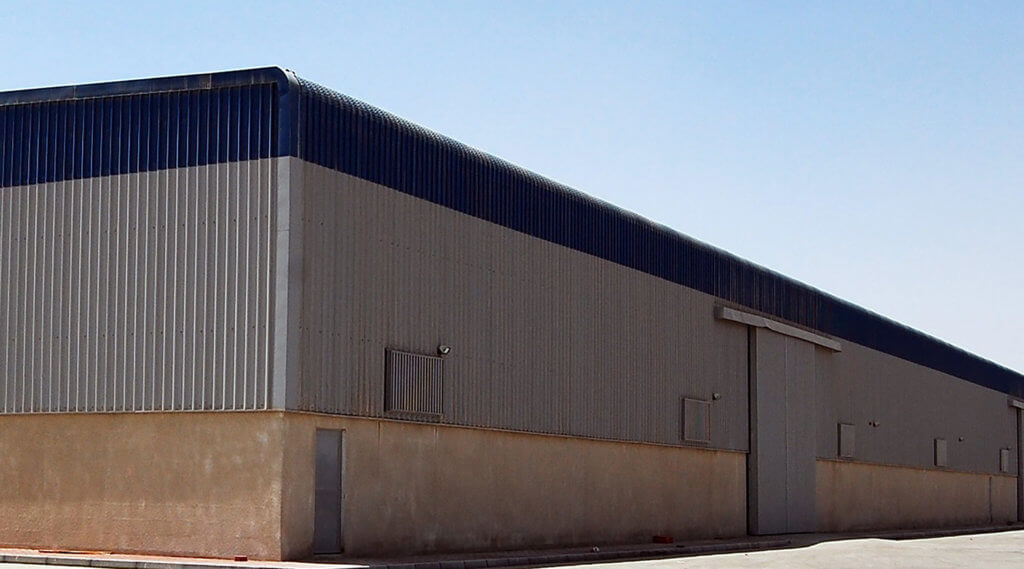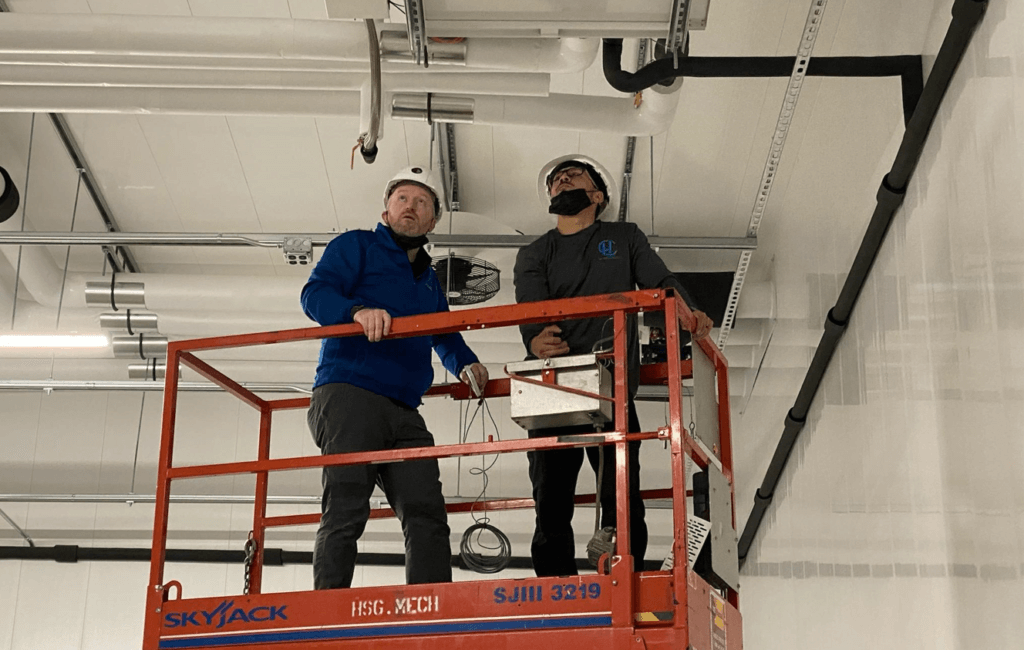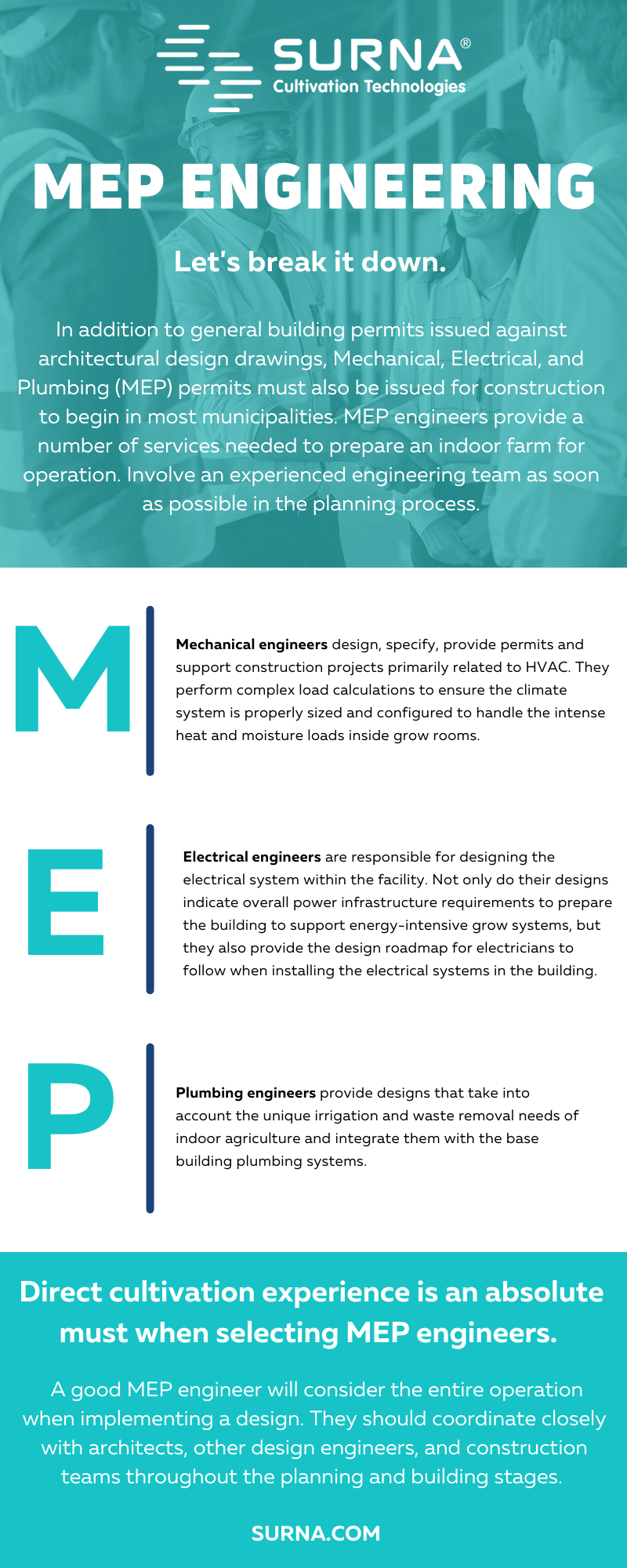Retrofitting means to take something that exists and to renovate or upgrade it for a new application or a new standard of functionality. For controlled environment agriculture (CEA), this implies taking an existing building, and upgrading its mechanical, electrical, and plumbing (MEP) system to be suitable for indoor farming.
Growing plants indoors requires lighting, HVAC equipment, and other systems that consume electricity. The process of supplying light and watering plants creates a warm and humid climate that must be carefully managed. This combination of requirements makes MEP engineering for indoor ag incredibly unique.
What Is an MEP Retrofit?
There are three categories an MEP retrofit can fall under.
Purchasing An Existing Building
A retrofit may refer to the necessary evaluation and upgrading of a building’s existing mechanical, electrical, and plumbing systems when purchasing a building and renovating it to be suitable for CEA. This option provides an alternative to buying land and constructing a facility from the ground up. While in our experience this typically requires the same amount of time and expenditure as a new-build, it is not an uncommon choice, particularly in established urban areas.

Because growing plants in a controlled environment requires energy-intense lighting and HVAC, and because of its unique dehumidification and irrigation demands, most commercial buildings will not be suitable for your farm’s needs right away. In this type of retrofit, it’s important that your engineers properly evaluate the buildings’ existing equipment and ductwork and determine if you’ll need any electrical or plumbing upgrades. They’ll also need to work with your general contractor and architect to ensure the facility to brought up to code
Replacing a Failing System
Imagine you’ve invested in a building that will allow you to grow your crops all-year-long. You’ve received the plans, submitted the permits, poured the foundation, installed the equipment, and moved your plants in, and just one year later you realize there is a big problem. Your temperature is too high. You try to crank up the AC, but it overloads the unit. The humidity begins spiking, and your plants begin to suffer. Not only have you lost a full harvest, but you’ve come to realize that the climate control system you invested in isn’t suited for indoor agriculture.
It’s a scary situation to face as a business owner, but we have seen our fair share of cultivators who found themselves with a failing environment. We’ve helped retrofit HVAC systems for grows ranging from small craft operations to 100k+ sq. ft. commercial producers, and the common thread we find each time is that they worked with engineers who were not prepared to provide a system equipped for CEA.
While the best approach to avoiding facility design mistakes is to be proactive and get your MEP system designed correctly the first time, if you find yourself losing harvests and managing failing equipment, an expensive retrofit may be your only option.
Upgrading Your Equipment
As time goes on, your old equipment will eventually begin to show signs of wear and tear, causing it to run less efficiently and at some point, fail entirely. We advocate for implementing a proper preventative maintenance program to help extend the life of your equipment for as long as possible. This includes regularly replacing filters, cleaning coils, and recruiting a knowledgeable technician to service and maintain the units. Still, after years of successful operation, the time will come to replace your units.

Another consideration is that technology improves over time, and you may find areas for potential improvement that could seriously impact your bottom line.
What to Consider When Retrofitting a Building's MEP Systems for Cultivation
Structure
There are several structural considerations your design teams will need to take into account when assessing your facility. Here are a few general questions they must address:
- Can the building’s roof support heavy mechanical equipment? If not, what modifications need to be made?
- Is there existing ductwork that needs to be replaced or removed, depending on the HVAC technology you choose?
- Is there enough space for cultivation equipment?
- Is mold or asbestos mitigation necessary?
- If growing cannabis, is odor mitigation necessary?
- Are insulation values consistent with current energy codes? If not, what modifications need to be made?
Close coordination between the architectural, structural, and MEP team will be required to answer these questions and help you to determine the financial impact (or feasibility) of a retrofit like this.
Electrical
Electrical engineers will assess the site to ensure you have adequate power supply and that your wiring is up to code. Knowing which equipment you will use – including HVAC and lighting systems – will help them more accurately determine your electrical needs. If you are retrofitting an existing building that was previously used for other purposes, major electrical changes, including power upgrades, will almost certainly be required. If you are updating a facility that has already been used for cultivation, the electrical upgrades will be less intense, but will still need to be addressed.
Plumbing (Irrigation and Wastewater)
Most commercial buildings must accommodate the need for toilets and sinks, but the plumbing infrastructure of an indoor cultivation facility is far more complex. You must be able to facilitate regular irrigation schedules and the removal of wastewater.
There are ways you can minimize wastewater that may also help reduce your operating costs significantly. For instance, tightly controlling your irrigation strategy reduce runoff water that is unused by the plants can reduce your water consumption. Furthermore, you can potentially reclaim condensate, recycling the water you provide your plants once they transpire it into the air, and recapturing it through the dehumidification system. These strategies can lessen the impact of wastewater considerations in a retrofit.
No matter what, you will still need to account for the water volumes you will need to bring into the building and how much you will need to remove from the building once used. Your plumbing engineer will perform these calculations and provide designs for any necessary plumbing retrofits.
How to Choose the Right MEP Engineer For Retrofitting an Indoor Grow
You should carefully vet you MEP engineer if you are considering a retrofit. Ensure they have successful experience on other CEA projects, and that they can provide stamped construction documents in the location in which you plan to build. Speak to and obtain proposals from multiple providers to compare and contrast not just cost, but the depth and breadth of the engineering scope and support being offered. As a reputable leader in the cannabis and indoor food production spaces, we advocate for growers to seek out proposals from more than one potential vendor. This will allow you to compare your options and feel confident when you find the right fit.
An MEP company like Surna Cultivation Technologies simplifies the process by providing mechanical, electrical, and plumbing services as well as other facility design solutions including architectural design, HVAC equipment, lighting, and more.
If you’re ready to discuss an MEP retrofit with an engineer, contact us today.


